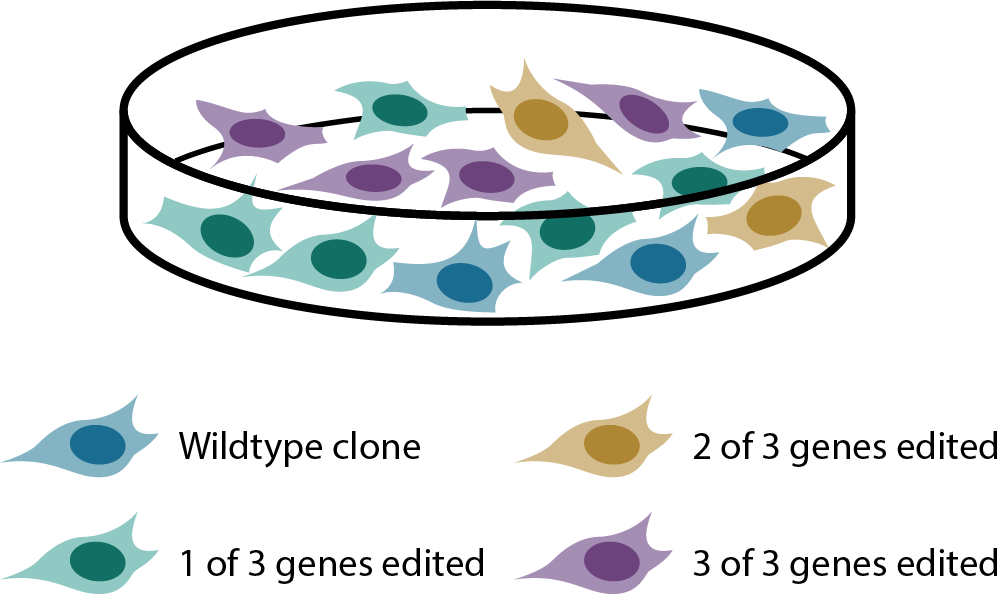Knocking out multiple genes in a single cell allows for a more complete study of biological phenotypes and leads to better understanding of synergistic and related effects.
Although transfections are done with a population of cells, here we show that optimal transfection conditions can lead to a high number of single cell clones within the population containing up to at least three different genomic edits, when synthetic guide RNAs are multiplexed into a single reaction (Figure 1).

Gene editing with multiplexed guide RNA delivery diagram

Figure 1. Many clones within a transfected population are edited at three different loci after a multiplexed editing experiment.
Gene editing with multiplexed guide RNA delivery diagram
A proof of concept experiment
We transfected Edit-R synthetic crRNA and tracrRNA targeting the genes AXL, DNMT3B, and PPIB (Table 1) either into a HEK293T cell line stably expressing Cas9, or co-transfected with Cas9 mRNA or Cas9 protein. From each of these experiments, 40-90 clones were generated using a limited dilution method. For each Cas9 delivery method, sixteen random clones were analyzed for insertions and deletions (INDELs) by PCR amplification of the target locus and Sanger sequencing. Sanger sequencing traces were resolved using a CRISPR ID tool (http://crispid.gbiomed.kuleuven.be/).
| Gene | Guide RNA targeting sequences |
|---|---|
| AXL | GGUUCCAACUCACCCAUAAC |
| DNMT3B | GCUGAAUUACUCACGCCCCA |
| PPIB | GUGUAUUUUGACCUACGAAU |
Table 1. Guide RNA sequences used to target three genes in multiplex.
Robust multiplexed editing observed from 16 randomly chosen clonal cell lines
From the analysis of sixteen clones, we observed that over thirty percent had INDELs at all three targeted loci when using a cell line engineered with Horizon’s Cas9 lentivirus for stable expression of Cas9, twenty five percent when the three guide RNAs were co-delivered with Horizon’s Cas9 mRNA, and six percent when the guide RNAs were transfected as RNP with Horizon’s Cas9 protein. For clones where all three genes were not edited simultaneously, over half of the analyzed clones still had at least one gene edited (Table 2).
| Cas9 delivery | # of sequenced clonal lines | Wild type clones | 1 of 3 genes edited | 2 of 3 genes edited | 3 of 3 genes edited | Percent of clonal lines with at least 1 gene edited | Percent of clonal lines with 3 of 3 genes edited |
|---|---|---|---|---|---|---|---|
| Cas9 stable | 16 | 3 | 6 | 2 | 5 | 81% | 31% |
| Cas9 mRNA | 16 | 3 | 7 | 2 | 4 | 81% | 25% |
| Cas9 protein | 16 | 2 | 10 | 3 | 1 | 88% | 6% |
Table 2. Number of clones that had INDELs detected at 1, 2, or 3 of the 3 targeted loci.
Efficient multiplexed gene editing with multiple Cas9 delivery methods
In conclusion, we show that multiple genes can be edited in a single cell using different synthetic guide RNAs in one transfection. Horizon’s Edit-R synthetic guide RNAs can be efficiently transfected with multiple methods of Cas9 delivery to meet your experimental needs. Experimental outcomes may vary by cell type and gene target(s), as some cell types may not tolerate multiple Cas9-induced dsDNA breaks or may be prone to genomic rearrangements during dsDNA break repair. Finally, CRISPR/Cas9 induced INDELs in the genome may or may not correspond to gene knockout, so verifying loss-of-function for each gene using an appropriate assay will be necessary.
